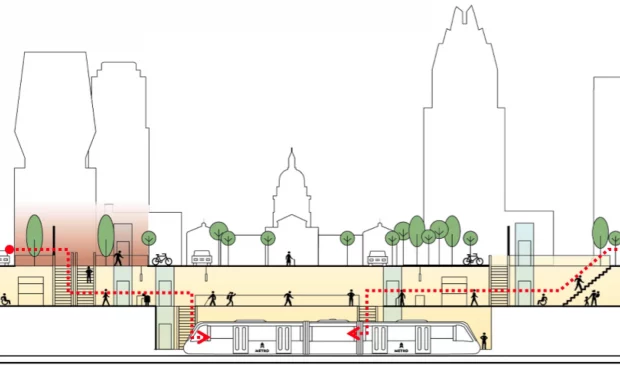City aims to get out of its own way with ‘fast-track’ permitting for Project Connect rail lines
Monday, October 24, 2022 by
Jonathan Lee An ordinance aimed at streamlining permitting for Project Connect has been making its way through boards and commissions in recent weeks – the latest sign of progress toward new rail and bus lines approved by voters in 2020.
On Tuesday, staffers from the city’s Project Connect Office and the Austin Transit Partnership gave a presentation on the ordinance to the Zoning and Platting Commission.
The code changes, said Donna Galati with the Project Connect Office, are needed to “ensure that we don’t get in our own way as we implement Project Connect.”
The most substantial change would allow entire transit lines to be approved under a consolidated fast-track site plan process. “Our Land Development Code is written for single-lot development,” Galati said. “It would not be a good use of resources to have hundreds of site plans for permitting miles of rail.”
Other changes include extending the site plan expiration period to 10 years for transit projects, allowing rail maintenance facilities by right on land zoned Public (P), and requiring regular monitoring of construction noise levels.
The ordinance provides a space for any future Land Development Code changes related to Project Connect, making the job of staffers easier as they review transit projects. The ordinance came about through a City Council resolution from last October.
Transit Forward, a nonprofit set up to ensure successful implementation of Project Connect, supports adoption of the ordinance without delay.
“Transit Forward sincerely appreciates the city’s Project Connect Office for proposing these fast-track modifications, and we strongly believe that these changes would prudently and appropriately expedite the construction of light rail and MetroRapid bus lines, making sure our friends and neighbors get what they voted for sooner rather than later,” the nonprofit’s board wrote in a statement.
The proposed ordinance comes amid cost increases and discussion over revisions to the project’s initial scope and timeline.
Costs have escalated due in part to inflation and high construction and labor costs. “These are things that are affecting infrastructure capital projects all over the country,” said Jennifer Pyne, senior director of the Austin Transit Partnership. “And we’re certainly not immune to that.”
Other cost drivers include higher land values, which make eminent domain acquisitions more costly, and design changes, particularly the possibility of longer subway tunnels.
Galati suggested that speeding up permitting could help bring costs down, citing a report by the Eno Center for Transportation. “The report identified local regulation, permitting and decision-making procedures throughout the United States as an obstacle to achieving cost-effective transit systems on par with those of peer nations,” Galati said.
In light of cost increases, the Project Connect team is gearing up to discuss potential changes to the initial scope and timeline of the light rail lines. “We’re just taking a real hard look at that right now, and we’ll be working with the community into 2023,” Pyne said, emphasizing that the goal is still to deliver the program approved by voters on time and on budget.
Tangible progress has already been made on parts of Project Connect. Construction is underway for the Pleasant Valley and Expo MetroRapid bus lines as well as a new Red Line commuter rail station next to Austin FC’s Q2 Stadium. The two MetroRapid lines are scheduled to open by summer 2023, with the opening of McKalla Station planned for fall 2023.
ZAP decided to postpone discussion on the ordinance to its next meeting in order to evaluate recommendations proposed by Commissioner David King. The Planning Commission recommended the ordinance unanimously earlier this month with no changes. City Council is scheduled to vote on the ordinance Dec. 1.
The Austin Monitor’s work is made possible by donations from the community. Though our reporting covers donors from time to time, we are careful to keep business and editorial efforts separate while maintaining transparency. A complete list of donors is available here, and our code of ethics is explained here.
You're a community leader
And we’re honored you look to us for serious, in-depth news. You know a strong community needs local and dedicated watchdog reporting. We’re here for you and that won’t change. Now will you take the powerful next step and support our nonprofit news organization?







